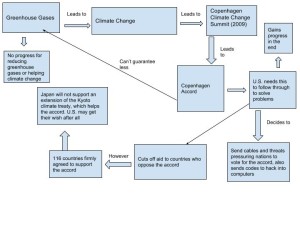2) The way my diagrams flows, is that it starts from the left with greenhouse gases, then continues to the right, moves downwards, and then moves towards the left again. It first starts with the reason behind the meeting for the Copenhagen Climate Change Summit in 2009 that established the Copenhagen Accord which I describe next in my diagram. The Accord didn’t promise any greenhouse gas cuts, which many countries that didn’t support the accord were probably able to see. However, following through the diagram, the U.S. needed the accord to pass to solve their own issues. I then made an arrow showing that the U.S. made progress in the end due to help from Japan when they decided not to support another reform, the Kyoto Climate Change Treaty. I wanted to contrast progress with no progress, so I put a box coming off of greenhouse gases to show that no progress was made in relation to trying to reduce greenhouse gases and climate change. This contrasted with the progress the U.S. made. In my diagram, I also described the malicious acts the U.S. carried out such as sending threats to other countries, cutting off aid, and hacking into computers. The arrows are used to keep the flow of the story moving, or show what the actions from the previous box before led to. Overall, my diagram describes the research from the article in a simpler way that you could read through my diagram and understand what happened with the cable leaks instead of reading through the whole article.
3) Normally I would say that information that is supposed to be kept private should be, but in this case I think it was good that the cables were released because we got to see how mischievous the U.S. was in trying to get countries to agree with the Accord. The U.S. was being selfish, instead of altruistic, in only caring that some of our countries problems were solved. The U.S. was being especially selfish because the Accord really wasn’t helping climate change, and that was the overall point of the meeting. The U.S. should in no way try to get other countries to be on our side by using tactics such as threats or illegally hacking into computers. The U.S. might have been able to get what they want from that, but in the future if the U.S. needed those countries they threatened to be on our side, the countries would have no respect for the U.S. The U.S. should’ve instead tried to suggest that the UN should have another meeting to revise the accord and change it to where it would actually cause a positive impact on the environment through mitigation efforts. The U.S. actions have no doubt only gained us enemies, distrust, and soon we will have to make adaptation efforts from the impacts of climate change that will continue to occur. It seems like the U.S. was trying to make it look like they were doing something similar to the collective action problem represented in this module. They wanted to make it look like they wanted to help with climate change, when really though they’re actions they showed more of a concern for, “individual interest to keep emitting” things into the environment such as greenhouse gases.


[http://geog030.dutton.psu.edu/2016/04/08/los-gatos-monte-sereno-examination-and-proposal-biodiversity/]
Hi I’m Cody, I liked your analysis of the US’ actions regarding the cables and the Accord. And I liked your first sentence of the third section “Normally I would say that information that is supposed to be kept private should be, but in this case I think it was good that the cables were released because we got to see how mischievous the U.S. was in trying to get countries to agree with the Accord.” The rhetoric of this sentence was really strong!
Hey I think you made a great diagram based off of the article. Mine was similar but a little simpler than yours. I agree with you that the information should have been released because it’s important to see what the US did. The US definitely gained enemies from this but in the long run I think it could be very helpful to the world.
Here’s a link to my post: http://geog030.dutton.psu.edu/2016/04/08/climate-change-michael-celoni/